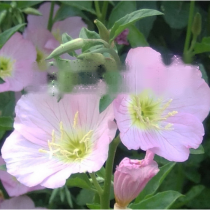
Chinese name: Beautiful evening primrose
Latin name: Oenothera speciosa
Alternative names: Night primrose, evening primrose, powdery moon See grass
Distribution area: Native to the temperate zone of America, mainly distributed in subtropical evergreen and deciduous broad-leaved forests.
Method of cell division: mitosis
1. Morphology of beautiful evening primrose
Beautiful evening primrose is a perennial herb with very thick taproot and clustered stem veins , 30 cm to 55 cm in length, with many branches. The upper part is pubescent and also very bushy, and the lower part is purple. The leaves at the root are close to the ground and are oblanceolate, with a length of 1.5 cm to 4 cm and a width of 1 cm to 1.5 cm. The front end is relatively sharp or blunt. The petiole is lavender, 0.5 cm to 1.5 cm in length, and the leaves at the root will gradually wither when flowering. The buds are green, conical-cylindrical in shape, and have a length of 1.5 to 2.2 cm.
2. Habits of beautiful evening primrose
Beautiful evening primrose is native to southern Texas to Mexico, and is also found in the southwestern United States, Central America and the warm temperate mid-mountain zone of South America . It is cultivated in Eurasia (such as the Asian Himalayas, India, Nepal, Myanmar, etc.), South Africa, etc., and it is wild. my country's Zhejiang, Jiangxi (Lushan), Yunnan (Kunming), and Guizhou are wild. Strong adaptability, acid and drought resistance, not strict on soil requirements, generally neutral, slightly alkaline or slightly acidic soil, good drainage, can grow on loose soil, soil is too wet, roots are prone to disease. It is an annual plant in the north, and a biennial plant in the south of the Zhunhe River. Born in 1000-2000 meters above sea level in wasteland grasslands, semi-shady places along the ditch.
3. Cultivation of beautiful evening primrose
The cultivation method of beautiful evening primrose can be propagated by seed sowing, and the sowing time can be selected in autumn or spring. After the seeds are sown, the soil should be kept moist, and the seeds can germinate about 10-15 days after sowing. It has strong adaptability, acid and drought resistance, and is not strict with soil requirements. Generally, it can grow on neutral, slightly alkaline or slightly acidic loose soil. But the soil is too wet and the roots are prone to disease. Ground cover flowers. Evening primrose, biennial, plant height 1-1.5m, whole plant hairy, branched, yellow flowers, about 4-5cm in diameter, clustered in pairs in the leaf axils on the upper part of the branch, flowering from June to September . Cold-resistant, barren-resistant, hi light, avoid water.
Guess you like it
Daisy | Chrysanthemum | Pear Flower | Wisteria | Calla Lily | Rose | Cymbidium | Rosemary | | white palm | kapok |
apricot flower | bark lotus | oleander | rose flower | mimosa | |
Saffron | Forget Me Not | Sunflower | Lily of the Valley | Gardenia | Poppy | Poppy | | Chunlan | Jasmine | Osmanthus | Paeonia | Campanulaceae | Datura | Violet | Anthurium | Camellia | Narcissus |
![[Dog Training 5] The training method of pet dog dining etiquette](/static/img/12192/12192_1.jpg)




